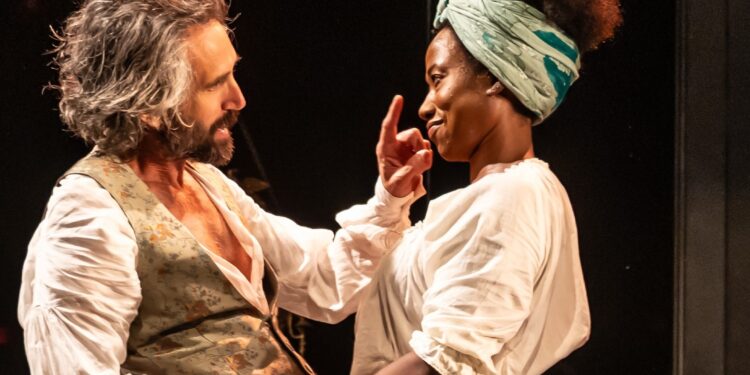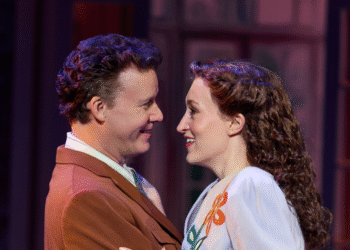(Note: There may be some inadvertent spoiler alerts. I’m trying not to do that.)
Canadian Stage’s Slave Play and its controversially charged text are not for the faint-hearted. The performance itself? That’s completely different.
Jeremy O. Harris’s Slave Play strikes a painful chord, whether intentionally or not. The story centers on three interracial couples who explore themes of trauma, power, control, sex, and race. These couples are in therapy on a former Southern plantation in the American South. Why? The Black partner is struggling to experience sexual pleasure during intimacy with their white partner. The title references the historical context of slavery, with which audiences are likely already familiar. The text also delves into role-playing among the characters, which adds to the controversy (and yes, even humour) surrounding the work.
Canadian Stage also states that Slave Play is meant for audiences 18+. Remember that. Forewarned is forearmed in this case.
Harris’s text serves at least three dramatic purposes in theatre: to foster empathy, to challenge and to empower. American poet Morgan Parker also notes in the programme: “[Slave Play] could open up regrets and secrets, and what you find could be [shocking]. But there’s nothing in [the play] that part of you doesn’t already know.” That shock was evident among the audience members around me. I heard gasps from those nearby, and I could feel my own jaw drop in response. My guest pointed out that the two people sitting beside us did not return after the intermission, which was probably for the best, given how the plot unfolds after the intermission. Were regrets and secrets opened in this couple?
However, what Morgan Parker states is true: there’s nothing in Harris’s text that we as an audience don’t already know. Historical and contextual understanding of slavery is wrong. Period. And?
Harris’s text touches on sensitive themes. From a faith perspective, I find it difficult to empathize with the characters—six individuals who are lost and searching for direction. Their dependence on racial identity seems to have damaged the close connections they once shared in their relationships, which now appear almost impossible to mend. Their secrets and regrets come to light and are addressed with a sometimes comically amusing commentary and tone. While Beck Lloyd and Rebecca Applebaum’s therapists, Teá and Patricia, suggest the potential benefits of therapy, Sébastien Heins’ Phillip, and Gord Rand’s Jim dismiss this idea as “bullshit.” I often wonder why the Black partner in the relationship hasn’t left if they feel unfulfilled—a choice that seems typical in today’s disposable culture. It puzzles me why these characters remain together despite their apparent unhappiness.
American actor Morgan Freeman, in an interview, told 60 Minutes reporter Mike Wallace that the only way to get rid of racism is to stop talking about it. Martin Luther King Jr once had a dream in 1963 for his four children where “[they] will live in a nation where they will not be judged by the colour of their skin but by the content of their character.” Again, Slave Play’s text does neither of these. It continues to judge by skin colour. It continues to keep talking about the racial element right to the shocking end when one of the characters says Thank you for what has just occurred.
It’s challenging to empathize with the characters in Harris’s text who inhabit a completely different world and a view from which I live.
Aside from the controversially charged text, what about the actual production itself?
That’s completely different.
The production remains stunning.
It encourages the audience to reflect, listen, and engage with differing perspectives of the play’s text, regardless of how uncomfortable personal reactions may be from either a white or black viewpoint. This Slave Play emerges as empowering in its controversiality, particularly through Sophia Walker’s Kaneisha, who delivers a performance deserving of a Dora Award nomination. At the end of the play, it’s clear why Walker takes the final bow at the curtain call.
The production is directed with exceptional care and insight by Jordan Lafrennier. If you have the opportunity, I highly recommend reading his account of visiting Southern plantations in the U.S. as part of his preparation for rehearsals. It seems that both Lafrennier and Intimacy Director Anisa Tejpar collaborated closely throughout the process to ensure that respect and dignity were maintained for everyone involved. The creative team behind the production has done a wonderful job creating a visual story that captivates the audience. Notably, Rachel Forbes’ impressive costume designs representing Southern plantations, Daniel Bennett’s evocative lighting, and Gillian Gallows’ stunning mirrored set design all contribute to this immersive experience at the top of the show. Additionally, Thomas Ryder Payne’s sound design enhances the overall atmosphere.
I am reluctant to reveal more about the talented Canadian theatre artists, the characters they portray, and their interactions as an exceptional ensemble. It might spoil the plot for future audiences. Although the plot itself may not be entirely original, as Parker states above, its shock value is the drawing card.
Slave Play is brazen, bold and bizarre. But it’s also one that has to be seen and experienced in all its rawness.
Running time: approximately two hours and 15 minutes with one intermission.
The production runs until November 2 at the Berkeley Street Theatre, 26 Berkeley Street, Toronto. For tickets: canadianstage.com or call (416) 368-3110
CANADIAN STAGE presents the Canadian premiere
SLAVE PLAY by Jeremy O. Harris
Directed by Jordan Lafrennier
Set Design: Gillian Gallows
Costume Designer: Rachel Forbes
Lighting Design: Daniel Bennett
Sound Design: Thomas Ryder Payne
Intimacy Director: Anisa Tejpar
Choreographer: Natasha Powell
Stage Manager: Neha Rose
Performers: Rebecca Applebaum, Justin Eddy, Sébastien Heins, Beck Lloyd, Kwaku Okyere, Gord Rand, Amy Rutherford, Sophia Walker
















